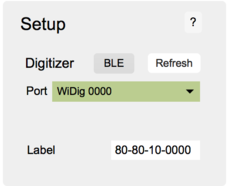Difference between revisions of "EditorX-80 QuickStart USB-microDig"
(Copied from EditorX-75 QuickStart USB-microDig, revision 2021) |
|||
| (8 intermediate revisions by the same user not shown) | |||
| Line 3: | Line 3: | ||
For this walkthrough, you will need: | For this walkthrough, you will need: | ||
| − | *A USB-microDig and its drivers (see below). | + | *A USB-microDig (with hardware v7.5) and its drivers (see below). |
*A Turn (or other) sensor for testing. | *A Turn (or other) sensor for testing. | ||
*[http://icubex.com/editorx EditorX software]. | *[http://icubex.com/editorx EditorX software]. | ||
*[http://icubex.com/connect Connect software] (included in the EditorX software package). | *[http://icubex.com/connect Connect software] (included in the EditorX software package). | ||
| + | *[http://icubex.com/silabs SiliconLabs driver] | ||
| + | *[http://icubex.com/loopmidi LoopMIDI] (Windows only) | ||
==Installing the USB-microDig== | ==Installing the USB-microDig== | ||
| − | + | Connect the USB-microDig's micro USB port via the supplied micro USB cable to a USB port on the computer. | |
| + | On both Windows and MacOS, you'll first need to add the USB-microDig as a virtual serial (or COM) port by installing its [http://icubex.com/silabs SiliconLabs driver]. | ||
| − | + | On MacOS, the drivers were installed correctly if the connected USB-microDig is listed in System Report (under About this Mac), in the USB section under Hardware. On Windows, the drivers were installed correctly if the USB-microDig is listed in the Device Manager (select from the menu that appears after right-clicking on the Start menu) as a serial (COM) port. | |
| + | |||
| + | On Windows, [http://icubex.com/loopmidi LoopMIDI] virtual MIDI port software needs to be installed as well. There's no need to create any ports in LoopMIDI, nor does the LoopMIDI system tray app need to be running. | ||
| Line 44: | Line 49: | ||
| − | 5. In the [[EditorX- | + | 5. In the [[EditorX-80_Setup | Setup section]] at the top, choose the USB-microDig with matching serial number. Upon connecting, the port menu will turn green. If EditorX failed to connect to the digitizer, maybe the Connecting section on the [[EditorX-75_Setup | Setup]] page can help you resolve the issue. |
| − | [[File:editorx- | + | [[File:editorx-80_setup.png|230px]] |
Latest revision as of 18:39, 14 August 2019
What you need
For this walkthrough, you will need:
- A USB-microDig (with hardware v7.5) and its drivers (see below).
- A Turn (or other) sensor for testing.
- EditorX software.
- Connect software (included in the EditorX software package).
- SiliconLabs driver
- LoopMIDI (Windows only)
Installing the USB-microDig
Connect the USB-microDig's micro USB port via the supplied micro USB cable to a USB port on the computer.
On both Windows and MacOS, you'll first need to add the USB-microDig as a virtual serial (or COM) port by installing its SiliconLabs driver.
On MacOS, the drivers were installed correctly if the connected USB-microDig is listed in System Report (under About this Mac), in the USB section under Hardware. On Windows, the drivers were installed correctly if the USB-microDig is listed in the Device Manager (select from the menu that appears after right-clicking on the Start menu) as a serial (COM) port.
On Windows, LoopMIDI virtual MIDI port software needs to be installed as well. There's no need to create any ports in LoopMIDI, nor does the LoopMIDI system tray app need to be running.
Connecting to the USB-microDig
1. Connect the Turn sensor (or any other sensor) to input #1 of the USB-microDig as shown below, with the red wire on top and the black wire on the bottom.
2. Start Connect.
3. The USB-microDig entry with matching serial number should be listed in bold in Connect. If you don't see the USB-microDig listed, verify that the SiliconLabs driver has been installed.
4. Start EditorX. Note that in MacOS, the next time you run EditorX and Connect isn't already running, Connect will be started automatically when starting EditorX.
5. In the Setup section at the top, choose the USB-microDig with matching serial number. Upon connecting, the port menu will turn green. If EditorX failed to connect to the digitizer, maybe the Connecting section on the Setup page can help you resolve the issue.
6. Click the "Off" button under number "1" in the Sensor Inputs section to turn on sampling of sensor input 1. The box right below the button will show the sensor value if changed. If it doesn't show anything, click the "Clear" button in the Settings section at the top right of EditorX, and try again to turn on the sensor input.
7. You're up and running. For further details about using EditorX, refer to the EditorX help pages.






